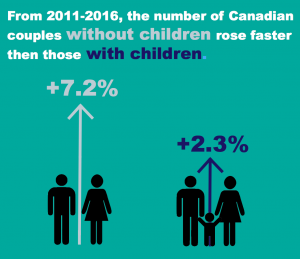More and more Canadian couples are opting to put off having children or not having them altogether, according to the latest 2016 Census data from Statistics Canada.
There are now 9.8 million families in Canada, and the proportion of couples living with children has been decreasing steadily for the last few years. Since 2011, the number of couples without children rose by 7.2%, while those with rose by only 2.3%.
This could be due to a number of factors, one of which is the decision to not have children in the first place. This is exactly what couple Sandy Kennedy and Gordon Danielson decided to do, who currently live in one of the Halifax areas where the percentage of couples without children has risen the most drastically in the last five years.
Kennedy and Danielson have been together for 31 years, and both believe that focusing on their careers was the driving force in their decision to not have children. “For two people with two incomes and no children, life’s pretty comfortable as long as you have friends and family that have kids,” says Danielson. “When we were both working, Sandy was working until midnight and I was away a lot. Can you imagine trying to raise children?”

Sandy Kennedy speaking on why she thinks more employment opportunities for women is affecting the number of childless homes.
Kennedy also believes greater opportunities for women in the workforce is affecting the growing number of women who wish to hold off on starting a family, saying “I think there’s more emphasis on women having careers first before having children. And then I think maybe they reach a threshold where it becomes too late to have children…It’s all about responsibility, at least that’s what it was for me. I didn’t want the responsibility, it was all I could do to handle my job.”
As Kennedy strokes their cat Gypsy, she adds laughing, “‘we didn’t even want a dog. We got a cat because that was easy.”
However, they have noticed that in their neighbourhood, its not necessarily families choosing not to have children that are creating so many childless homes. Kennedy says, “There are more empty nesters in our neighbourhood than those like ourselves who chose not to have children.” Empty nesters here refers to couples and parents whose children have left for university or have simply moved out of the home, leaving the parents alone.
This applies to the Millier family, residing in an area of Halifax were childless homes are on the steady increase. Children Grant and Claire are in their early twenties, and have since moved out of the house to go to university and move into their own apartments within the city.
Mother Maureen Millier says in her own childhood home of six siblings, it was customary to continue living at home until you were married in order to save money and keep the family together. She believes the reason so many children have less stress when leaving home is due to the power of social media and instant communication, saying “there seems to be a little bit less of a resistance to see your child move on to do different things… I can talk to them anytime and anywhere in the world and not worry so much about what’s happening with them.”
This rise of childless homes, from those who choose not to have kids and empty nesters as well, is certainly a trend in Nova Scotia. According to the census data, Nova Scotia has the highest percentage of couples without children than any other province or territory at 57.2%. Diverse family structures are on the rise, while the proportion of nuclear family units decreases more with every year.

